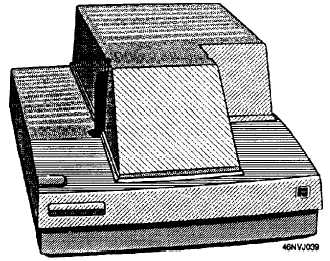make color corrections before the image is scanned into
a digital file. By making these adjustments before
scanning an image, you can save time and file size.
Scanners are produced by a number of manufacturers.
Scanners used in Navy imaging facilities are produced
by Nikon and Kodak (fig. 3-7).
Once an image is converted to digital format, the
data is passed from the scanner to the computer through
an interface. Because of the enormous amount of data
involved in electronic imaging, information is passed
through a SCSI.
A SCSI is a special kind of parallel interface that
allows for faster data transmission. The SCSI interface
permits a number of peripheral devices to be connected
to the computer through a single SCSI port. This is
accomplished by chaining the devices together with a
SCSI cable. The last device in the chain must have a
special adapter, known as a terminator. Some devices
have built-in terminators.
Each device in the SCSI chain is identified by a
unique identification number. When the scanner is
connected, you must verify that none of the peripherals
have the same identification number. These
identification numbers may be changed by using either
dipswitch settings or software.
The scanner uses two programs to operate. One
program is a paint program to manipulate the image
once it is in the computer. The second program is a
driver that acts as a translator between the scanner and
the paint program. Once the image is digitized,
Figure 3-7.—Kodak 7720 thermal-dye transfer printer.
limitless modifications and enhancements can be made
to the image.
Because a scanner scans at such high resolution, the
end file is quite large. Thus a considerable amount of
storage space is required. It is common for a 24-bit
color image to require 20 to 25 megabytes of storage.
COMPUTER PLATFORM AND SOFTWARE
The entire electronic workstation is designed
around a computer (fig. 3-8). There are three major
computer platforms in use for digital photography—the
Apple Macintosh, PCs (IBM or compatibles), and
Unix-based machines. The most popular computer for
digital imaging is the Apple Macintosh. However, PCs
and IBM compatibles are also used for digital imaging.
They are becoming more popular in the digital-imaging
marketplace. Unix-based workstations are used for
science-oriented operations and high-volume
publishing of books and technical manuals. Therefore,
Unix-based machines are not commonly found in Navy
imaging facilities.
Regardless of whether you are using an IBM
compatible or a Macintosh platform for electronic
imaging, the applications are basically the same.
Specific computer systems are not covered in this
training manual.
Only the principles that apply to
electronic imaging are discussed.
Computer Configurations
As a guideline, the computer must have a minimum
of 8Mb of RAM. For work efficiency, you need at least
32Mb of RAM. Storage may also become a problem
because of the large-size file of color digital images. A
high-resolution scanned image can require 250
megabytes or more of memory. A hard drive in excess
of 600Mb is not uncommon for an electronic-imaging
workstation.
The computer system must also have sufficient
expansion slots to install interface cards for add-on
peripherals, such as scanners, film recorders, and
printers. A number of interface cards are available for
both Macintosh and PCs that convert analog images to
digital format.
Software
Like computer platforms, a vast number of software
packages are available for scanning and modifying
images. Computer software (programs) makes it
possible for you to communicate with the hardware.
3-11



